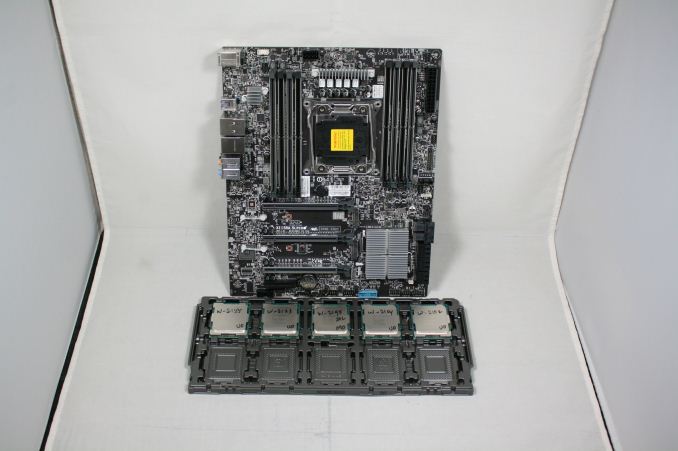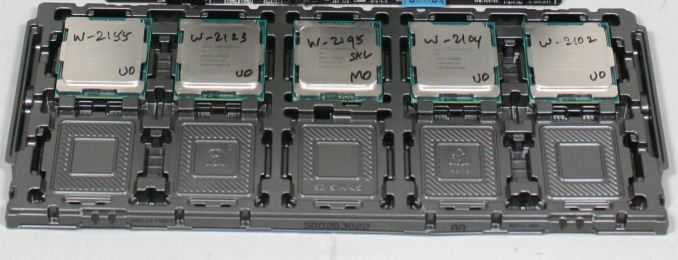The Intel Xeon W Review: W-2195, W-2155, W-2123, W-2104 and W-2102 Tested
by Ian Cutress & Joe Shields on July 30, 2018 1:00 PM EST- Posted in
- CPUs
- Intel
- Xeon
- Workstation
- ECC
- Skylake-SP
- Skylake-X
- Xeon-W
- Xeon Scalable
Conclusion: Is Intel Serious About Xeon W?
In this review, we have covered the performance on three of the more popular Xeon W processors, as well as two off-roadmap parts, and discussed that the Intel’s decision to bifurcate the way its workstation and consumer processors work has put more questions on the table for prospective buyers.
This ultimately comes down to the question: Is Intel Serious About Xeon W? If we ask Intel about this, of course the answer to them is yes – they want to have target markets and have a product portfolio that they feel will fit with that user base. However I am not so sure.
Xeon W was launched a lot later than both the Xeon Scalable platform and the equivalent Skylake-X consumer platform. The messaging behind Xeon W is unclear to a large degree, with only a limited amount of PR invested into it, unlike Xeon Scalable or Skylake-X. The decision to split the market between consumer and workstation, despite having a common socket, has minimized the accessibility of the workstation platform: fewer discussions are being had about the hardware, because there’s little room for a truly mix-and-match scenario as with previous generations. At no point in Intel’s messaging were we offered review samples for example, which is usually an indication that the product line is not one that the product managers are looking to promote. Only Intel’s latest Xeon E designs, released 10 months after the first equivalent consumer parts, beats Xeon W in terms of how un-exciting it can be to try and discuss talking about a platform. Intel does not want to sample Xeon E, either.
So will Intel lose workstation market share to AMD? If I am being so pallid, what are the financial ramifications for this market? AMD’s Threadripper looks like an appealing platform for workstation users for sure, but AMD is not without its own issues. Intel is the incumbent, and has embedded itself with a large number of OEMs and end-users for years, making it difficult for AMD to break that market. AMD’s chiplet design will take a few generations to get used to, so users might stick with ‘what they know’, regardless of any cost/benefit analysis. There is also the discussion of ECC support on Threadripper, for which the messaging has been somewhat unclear: technically it should support up to ECC LRDIMMs, however it does depend a lot on whether the motherboard vendor has qualified their product for RDIMMs or LRDIMMs – most of them are not, complicating the issue. If AMD wanted to tackle this space, they need an ASUS or a GIGABYTE to build a ‘workstation focused’ motherboard, with confirmed ECC and co-processor support. GIGABYTE’s Designare line and MSI’s upcoming X399 Creation might be aimed at this, but it really does require a razor-sharp message to get through.
All this confusion means that while AMD can be competitive in most tests, Intel is expected to remain the market leader for the foreseeable future.
I’m Sold on Xeon W: Tell Me About Performance
As our benchmarks are anything to go by, there is a lot of parity in performance between Intel’s Xeon W and Intel’s Skylake-X product lines. Xeon W takes a hit in memory workloads, because of the memory support: ECC RDIMMs are typically run at base JEDEC sub-timings, and so our DDR4-2666 memory was run at 19-19-19, compared to the 16-16-17 on the consumer platform which is more typical.
Our Xeon W results are skewed a bit towards the low-end processors, mostly because three of the five units we managed to acquire were quad-core processors. At this level, Intel’s now EOL Kaby Lake-X processors fared better, or the consumer Coffee Lake-S look like the better option, unless the user needs ECC or more PCIe lanes than the consumer products provide. The obvious counterpoint here is that if a user needs ECC, and is happy with 64 GB maximum memory support, then Intel’s own Xeon E is also an option, however we have not tested those parts yet (if any OEM can sample them to us, please let us know).
On the high-end, we do see the W-2195 sit behind the Core i9-7980XE in almost all benchmarks, which also means that for embarrassingly parallel workloads, it also sits behind the Threadripper 1950X. It still holds that Intel’s single threaded performance of the Xeon W, despite the lack of Turbo Boost 3.0, still gives it a significant advantage in single threaded workloads over AMD.
For users worrying about Spectre and Meltdown patches affecting performance, in our SYSMark tests we saw a 2-6% decrease over all the tests, with the hardest hit tests seeing a 12% decrease due to the correlation with storage.
Why Buy Xeon W?
The obvious reasons to buy Xeon W processors are just tick boxes: ECC memory, PCIe lanes, co-processor verification. If these are needed, the number of options for the rest of the system (particularly the motherboard) becomes slim, especially when factoring in price and total cost of ownership. A lot of the workstation market works on development cycles and high-throughput compute: the faster the compute, the quicker the prototyping. The fastest processors for a lot of that work, if CPU bound, are won by the consumer Core i9 or Threadripper, however if the above boxes are ticked, then Xeon W would be needed. Or Xeon Scalable, depending on budget.
A small side note to end: If anyone has access to any of the Apple-only Xeons (like the W-2150B) and would kindly let us borrow it for a review, please let me know over email.












74 Comments
View All Comments
mode_13h - Monday, July 30, 2018 - link
Just the fact that you need to map your VMs to stay on the same physical core, for best performance (i.e. so that the memory is local to it). If you do that, TR is actually a great VM solution.Death666Angel - Monday, July 30, 2018 - link
That doesn't sound so complicated as to be a "situation" for someone dealing with VMs. :) Seems like a general setup config thing that you just check off when you do it once.mode_13h - Tuesday, July 31, 2018 - link
Sorry, I meant "same physical die". Actually, best results are from setting affinity at the CCX (i.e. 4-core) granularity.SanX - Tuesday, July 31, 2018 - link
The day ARM announced it developed 8 and 16-core server and supercomputer chips at their usual price around $25 per 5 billion transistors, Intel Xeon prices would plunge 10-50x.Infy2 - Monday, July 30, 2018 - link
It would be helpful on those charts if there was an indicator how many cores/threads in CPU has.Ian Cutress - Monday, July 30, 2018 - link
We used to have that info in the graphs, however people found it redundant when it was elsewhere, and price/power was requested instead. It's hard to put all the info of every part into every graph!Death666Angel - Monday, July 30, 2018 - link
Can that not be coded as a tooltip/mouse-over text? That would be neat and not add clutter while adding information to those who want it. :)Ian Cutress - Monday, July 30, 2018 - link
Graphs are images generated locally from the data. I'm not au fait with how our back end works, but that's require more than a simple rewriteDeath666Angel - Tuesday, July 31, 2018 - link
Alright. :) Shame though, would be a useful feature for some. Maybe add it to an overhaul list, if such a thing exists. :)lkuzmanov - Tuesday, July 31, 2018 - link
I'm with Infy2 on this one, not sure who protested, but I think something like (10/20) next to the model wouldn't be too distracting or cost too much screen space. I caught myself having to go back to the first page of the article to check the core count of the Xeon parts. That said - great content, you're one of my daily go-to sites.